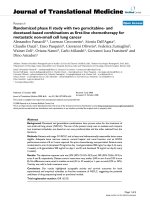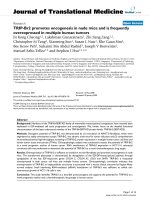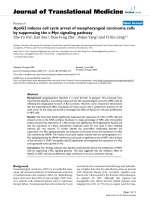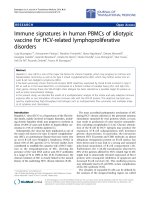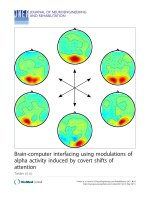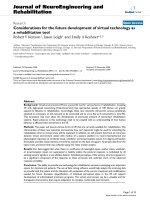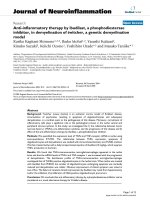báo cáo hóa học:" Thoracic myelopathy caused by ossification of ligamentum flavum of which fluorosis as an etiology factor" ppt
Bạn đang xem bản rút gọn của tài liệu. Xem và tải ngay bản đầy đủ của tài liệu tại đây (703.3 KB, 10 trang )
BioMed Central
Page 1 of 10
(page number not for citation purposes)
Journal of Orthopaedic Surgery and
Research
Open Access
Research article
Thoracic myelopathy caused by ossification of ligamentum flavum
of which fluorosis as an etiology factor
Wenbao Wang*
1,2
, Linghua Kong
3
, Heyuan Zhao
1
, Ronghua Dong
1
,
Jing Zhou
1
and Yun Lu
3
Address:
1
Spine surgery department, Tianjin hospital, No. 406 Jiefangnan Road, Hexi District, Tianjin City, 300211, People's Republic of China,
2
106 Fort Washington Avenue, Room 3H, New York City, NY, 10032, USA and
3
Hand surgery department, Tianjin hospital, No. 406 Jiefangnan
Road, Hexi District, Tianjin City, 300211, People's Republic of China
Email: Wenbao Wang* - ; Linghua Kong - ; Heyuan Zhao - ;
Ronghua Dong - ; Jing Zhou - ; Yun Lu -
* Corresponding author
Abstract
Purpose: To evaluate the clinical feature, operative method and prognosis of thoracic ossification
of ligamentum flavum caused by skeletal fluorosis.
Methods: All the patients with thoracic OLF, who underwent surgical management in the authors'
hospital from 1993–2003, were retrospectively studied. The diagnosis of skeletal fluorosis was
made by the epidemic history, clinical symptoms, radiographic findings, and urinalysis. En bloc
laminectomy decompression of the involved thoracic levels was performed in all cases. Cervical
open door decompression or lumbar laminectomy decompression was performed if relevant
stenosis existed. The neurological statuses were evaluated with the Japanese Orthopaedic
Association (JOA) scoring system preoperatively and at the end point of follow up. Also, the
recovery rate was calculated.
Results: 23 cases have been enrolled in this study. Imaging study findings showed all the cases have
ossification of ligamentum flavum together with ossification of many other ligaments and
interosseous membranes, i.e. interosseous membranes of the forearm in 18 of 23 (78.3%), of the
leg in 14 of 23 (60.1%) and of the ribs in 11 of 23 (47.8%). Urinalysis showed markedly increased
urinary fluoride in 14 of 23 patients (60.9%). All the patients were followed up from 12 months to
9 years and 3 months, with an average of 4 years and 5 months. The JOA score increased
significantly at the end of follow up (P = 0.0001). The recovery rate was 51.83 ± 32.36%. Multiple
regression analysis revealed that the preoperative JOA score was an important predictor of surgical
outcome (p = 0.0022, r = 0.60628). ANOVA analysis showed that patients with acute onset or too
long duration had worse surgical result (P = 0.0003).
Conclusion: Fluorosis can cause ossification of thoracic ligamentum flavum, as well as other
ligaments. En bloc laminectomy decompression was an effective method. Preoperative JOA score
was the most important predictor of surgical outcome. Patients with acute onset or too long
duration had worse surgical outcome.
Published: 02 November 2006
Journal of Orthopaedic Surgery and Research 2006, 1:10 doi:10.1186/1749-799X-1-10
Received: 06 January 2006
Accepted: 02 November 2006
This article is available from: />© 2006 Wang et al; licensee BioMed Central Ltd.
This is an Open Access article distributed under the terms of the Creative Commons Attribution License ( />),
which permits unrestricted use, distribution, and reproduction in any medium, provided the original work is properly cited.
Journal of Orthopaedic Surgery and Research 2006, 1:10 />Page 2 of 10
(page number not for citation purposes)
Background
Fluoride is an important element for bone mineralization.
It causes an increase in bone mass by stimulation of the
osteogenetic process [1]. However, over intake of fluoride
may cause fluoride intoxication, so-called fluorosis [2-
10]. Its typical clinical features include dental fluorosis,
diffuse densification of bone, calcifications of bony inser-
tions of many ligaments, discs, and interosseous mem-
branes, i.e. interosseous of the ribs, forearm, and leg,
posterior longitudinal ligament, transverse atlantal liga-
ment, ligamentum flavum, and membrana obturatoria [8-
10]. Thoracic spinal stenosis caused by ossification of lig-
amentum flavum (OLF) is a rare disease [11-20]. How-
ever, thoracic OLF caused by skeletal fluorosis is rather
rare. Only 6 cases have been reported in the English liter-
ature [3,13]. The authors' purpose is to evaluate the clini-
cal feature, operative method, and prognosis of thoracic
OLF caused by skeletal fluorosis.
Materials and methods
All the patients with thoracic OLF, who underwent surgi-
cal management in the authors' hospital from 1993–
2003, were retrospectively studied. The cases accorded
with the following criteria were included. Diagnostic cri-
teria for fluorosis: epidemic history including a long his-
tory living in a high fluorosis area; dental fluorosis; typical
X-ray findings including diffuse densification of bone, cal-
cifications of bony insertions of many ligaments, discs,
and interosseous membranes, i.e. interosseous of ribs,
forearm, and leg; urinalysis of fluoride may increase.
Diagnostic criteria for thoracic ossification of ligamentum
flavum: typical clinical symptoms and findings which
included numbness in the lower limbs and below the rel-
ative segment of trunk, motor weakness in the lower
extremities and difficulty in walking; physical examina-
tion showed increased lower limbs muscle tension,
increased in deep tendon reflexes and appearance of path-
ological reflex, i.e. Babinski sign. X ray, CT scan, and MRI
were used to confirm the diagnosis.
For each the patient, A-P view and lateral view X-ray of the
thoracic spine were taken. Then thoracic MRI was taken to
ensure the diagnosis and identify the involved segments.
CT scan was performed for the involved segments. A-P
view, lateral view X-ray of forearms and legs and A-P view
of the chest were also taken.
Indication of surgery: symptoms and signs of thoracic
myelopathy; CT scan and MRI demonstrated significant
thoracic canal stenosis; the symptoms and signs correla-
tion with the imaging findings.
En bloc decompression was performed on each patient. In
one patient combined with cervical ossification of poste-
rior longitudinal ligament, cervical open door decompres-
sion was performed additionally. In one patient
combined with lumbar stenosis, lumbar laminectomy
decompression was performed additionally.
Preoperative radiographic localization with a Kirschner
wire was used to confirm the operative level on the morn-
ing of operation day. After induction of general anesthe-
sia, the patient was placed prone with an indwelling
bladder catheter. The abdomen was decompressed to
avoid excessive epidural bleeding. According to the X-ray
localization result, a midline incision was made at the
appropriate level and extended to the fascia. Subperiosteal
dissection of the paraspinal muscles was performed using
electrocautery cutting. The spinous processes were short-
ened using rongeurs (not totally removed). The laminec-
tomy was performed with high-speed drill. The width of
the laminectomy was approximately one third the size of
the inside of the facet. After the laminae were totally
floated, it was taken off en bloc by holding the residues
spinous processes (Fig 4).
The ossified ligamentum flavum often adhered to the
dura mater. So, much care should be paid to avoid rupture
of the dura mater. Occasionally, the dura mater also ossi-
fied. In those cases, we did not take away the ossified dura
mater totally, just floated it. When coexistent lesions were
present at noncontinuous thoracic levels, clinical symp-
toms and neuro-imaging findings were examined. The
level considered to be the likely cause of clinical symp-
toms was then surgically treated. When coexistent lesions
were present at the cervical or lumbar region, the depres-
sion of the relevant region was performed.
The neurological statuses were evaluated with the JOA
scoring system of myelopathy preoperatively and at the
end point of follow up (table 2). The recovery rate,
described by Hirabayashi et al [21], indicating the degree
of recovery of normal function postoperatively, was calcu-
lated as follows: (postoperative JOA score – preoperative
JOA score)/(11- preoperative JOA score) ×100.
X-ray and CT scan were performed 3 days after the opera-
tion to conform the decompression levels and decompres-
sion area. X-ray was performed at the end of the follow up
to identify whether there was spinal instability.
Statistical analysis
Paired t test was used to analyze the differences between
the results before operation and at end of follow up. Mul-
tiple linear regression was conducted to determine the
quantitative variables best correlating to surgical out-
come. ANOVA was used to analyse differences among the
three groups according to the duration of preoperative
symptom. When the results of ANOVA indicated < 0.05,
further statistical analysis was followed to determine
Journal of Orthopaedic Surgery and Research 2006, 1:10 />Page 3 of 10
(page number not for citation purposes)
whether there was any significance difference between any
two groups. The statistical results were analyzed using the
Statistical Analysis System (SAS). Significance was
accepted for P-values of < 0.05 in all of the above analyses.
Results
Clinical presentation
74 cases of thoracic OLF were surgically treated at the
authors' institution between 1993 and 2003, 23 of which
(16 male and 7 female) were caused by fluorosis. The 23
patients ranged in age from 42 to 72 years (mean 54.8
years). 6 cases had acute onset of clinical symptom, 4 of
which had a traumatic history, 2 without markedly trau-
matic history. The other 17 cases did not have a traumatic
history and presented with progressive symptoms. Numb-
ness in the lower limbs and below the relative segmental
was the most common initial symptom in 17 of the 23
patients (73.9%). Motor weakness in the lower extremi-
ties and difficulty in walking as initial symptoms were
found in 6 patients. The details of the clinical findings are
shown in table 1 and table 3. The mean duration of symp-
toms between initial onset and operation was 37 months
(range 1 day–11 years). All of the 23 patients had a long
term, high fluoride area living history. Fluoride over
intake was from water in 21 cases (91.3%) or from coal
smoke in 2 cases (8.7%). 22 of 23 patients (95.7%) had
different levels of dental fluorosis. Urinalysis showed
markedly increased urinary fluoride in 14 of 23 patients
(60.9%).
Imaging study result
The mean number of involved segments is 4.17, with a
range from 1 to 9 (Fig 1). The ossified ligamentum flavum
displayed obscuration the margin of the lamina on the A-
P view X-ray in 8 patients (34.8%). On the lateral view X-
ray, 12 of 23 patients (52.2%) showed high density pro-
jection into the spinal canal at the level of compression.
All the ossified ligamentum flavum displayed the density
of cortical bone on CT scans and sometimes had a thin
gap between the laminae (Fig. 3c). All the ossified liga-
mentum flavum demonstrated triangular protrusion with
a low-signal intensity resembling cortical bone on MR
images (Fig 3a, 3b).
X-ray of forearms, legs, and chest showed ossification of
interosseous membranes of the forearm in 18 of 23
patients (78.3%) (Fig 2), of the leg in 14 of 23 patients
(60.1%), and of the ribs in 11 of 23 patients (47.8%).
Operation and the prognosis
The operation time ranged from 2.5 hours to 4.3 hours,
with a mean of 3.2 hours. The mean decompressed seg-
ments number is 4.35 (ranged from 2 to 8, table 3). Blood
loss ranged from 400 ml to 2800 ml, with a mean of 850
ml. Dura mater rupture occurred in 4 patients. Deep infec-
tion occurred in one patient. No postoperative neurologi-
cal deterioration occurred. All the patients were followed
up from 12 months to 9 years and 3 months, with an aver-
age of 4 years and 5 months. Paired t test showed that the
JOA score increased significantly at the end of follow up
(P = 0.0001, table 3). The recovery rate was 51.83 ±
32.36%. Multiple regression analysis revealed that the
preoperative JOA score was an important predictor of sur-
gical outcome (p = 0.0022, r = 0.60628, table 4). How-
ever, the sex, age, preoperative symptom duration, and
levels of OLF did not significantly influence the surgical
outcome. ANOVA analysis showed that patients with
acute onset (group 1) or too long duration (group 3) had
worse surgical result (P = 0.0003) (table 3). Further t test
showed that there was significant different between group
Table 2: summary of the JOA scoring system for the assessment
of myelopathy
neurological status score
lower-limb motor dysfunction
unable to walk 0
Able to walk on flat floor with walking aid 1
Able to walk up/downstairs w/handrail 2
Lack of stability & smooth reciprocation of gait 3
no dysfunction 4
lower-limb sensory deficit
severe sensory loss or pain 0
Mild sensory deficit 1
no deficit 2
trunk sensory deficit
severe sensory loss or pain 0
Mild sensory deficit 1
no deficit 2
sphincter dysfunction
unable to void 0
marked difficulty in micturition 1
minor difficulty in micturition 2
no dysfunction 3
Total score for a healthy patient is 11.
Table 1: Summary of clinical features observed in 23 patients
with OLF
Symptoms number of cases
numbness and sensory deficit 22
lower-limb weakness and gait disturbance 21
Low-back pain 8
"squeezing tight band" around chest or abdomen 6
neurological claudication 4
leg pain 12
fecal & urinary incontinence 18
knee and ankle hyperreflexia 18
positive patellar and ankle clonus 14
positive Babinski sign 15
Journal of Orthopaedic Surgery and Research 2006, 1:10 />Page 4 of 10
(page number not for citation purposes)
Table 3: Data on Patients With Ossification of Ligamentum Fluvam
case no. sex & age DPS &
group
JOA score levels & segment
number of OLF
levels & number of
decompression
recovery
rate %
pre-operation follow up
LEMTSLESSDTotalLEMTSLESSDtotal
1 M, 42 15m(2) 2 2 0 1 5 4 2 1 2 9 T12–L1 (1) T12–L1 (2) 67
2 M,62 3d(1) 3 2 1 3 9 4 2 1 3 10 T12–L1 (1) T12–L1 (2) 50
3 F, 46 32m(2) 3 1 1 2 7 4 2 1 3 10 T12–L1 (1) T12–L1 (2) 75
4 M,54 12m(2) 4 1 1 3 9 4 2 2 3 11 C7–T1(1) C7–T1(2) 100
5 F,64 4y(2) 2 1 1 2 6 4 2 1 3 10 T1–4(3) T1–4(4) 80
6 M,51 5y(3) 1 1 0 2 4 3 2 1 3 9 T3–5(2) T3–5(3) 71
7 M,42 2d(1) 1 1 0 1 3 2 2 1 2 7 T7–12(5) T7–12(6) 50
8 M,65 7y(3) 1 1 1 1 4 3 1 1 1 6 T8–L1(5) T8–T12(5) 29
9 M,55 11y(3) 2 1 1 3 7 2 2 1 3 8 T7–L1(5) T8–L1(6) 25
10 F,56 15m(2) 2 1 1 2 6 3 2 1 2 8 T9–L1(4) T10–L1(4) 40
11 M,59 1d(1) 2 1 0 1 4 2 1 0 1 4 T9–L1(4) T9–L1(5) 0
12 M,45 6m(2) 4 2 1 3 10 4 2 2 3 11 T10–L1(3) T10–L1(4) 100
13 F,50 5y(3) 2 2 1 1 6 3 2 1 2 8 T10–L1(3) T10–L1(4) 40
14* M,62 1d(1) 0 0 0 0 0 0 0 0 0 0 T10–L1(3) T10–L1(4) 0
15 M,50 18m(2) 2 2 1 3 8 4 2 2 3 11 T10–L1(3) T10–L1(4) 100
16* F,48 5y(3) 2 1 1 2 6 2 1 1 2 6 T10–L1(3) T10–L1(4) 0
17 M,54 1d(1) 0 1 0 1 2 0 1 0 2 3 T3–7 11
T10–L1(4+3) T10–L1(4)
18 M,59 8y(3) 2 1 1 2 6 4 2 1 2 9 T1–T5 T1–T5(5) 60
T9–L1(4+4)
19 M,58 7y(3) 1 0 0 1 2 2 1 1 2 6 T1–6 44
T9–L1(5+4) T9–L1(5)
20 M,56 6d(1) 2 1 1 1 5 3 1 1 2 7 C7–T9(9) C7–T4(5) 33
21 F,52 7m(2) 2 1 1 2 6 4 2 2 3 11 T8–12(4) T8–12(5) 100
22 F,72 7y(3) 2 2 1 1 6 4 2 1 2 9 T9–11 T9–11 60
L3–S1(2+3) L3–S1(3+4)
23 M,58 4y(2) 1 1 0 2 4 3 2 1 2 8 C3–6 C3–6 57
T10–L1(4+3) T10–L1(4+4)
DPS: duration of preoperative symptom. LEM: lower extremity motor; TS: trunk sensory; LES: lower extremity sensory; SD: sphincter dysfunction
Paired t test showed that there is significant difference between the JOA score of pre-operation and followed up (P = 0.0001). The mean recover
rate is 51.83%. ANOVA analysis of the three groups according to the DPS showed p = 0.0003. Further t test showed that there was significant
different between group one and group tow (P = 0.0004). There was significant different between group two and group three (P = 0.003).
However, there was no significant different between group one and group three (P = 0.197).
Journal of Orthopaedic Surgery and Research 2006, 1:10 />Page 5 of 10
(page number not for citation purposes)
A diagram of the OLF distribution of 23 patientsFigure 1
A diagram of the OLF distribution of 23 patients.
Journal of Orthopaedic Surgery and Research 2006, 1:10 />Page 6 of 10
(page number not for citation purposes)
Anteroposterior view radiograph of both forearms showed significant calcifications of interosseous membranes of forearmFigure 2
Anteroposterior view radiograph of both forearms showed significant calcifications of interosseous membranes of forearm.
Journal of Orthopaedic Surgery and Research 2006, 1:10 />Page 7 of 10
(page number not for citation purposes)
The en bloc removed lamina, note the nodular ossified ligamentum flavumFigure 4
The en bloc removed lamina, note the nodular ossified ligamentum flavum.
a, b. T1 and T2 weight MRI of thoracic spine showed continuous multi-level ossification of ligamentum flavum between T7–12Figure 3
a, b. T1 and T2 weight MRI of thoracic spine showed continuous multi-level ossification of ligamentum flavum between T7–12.
c. CT scan showed ossified ligamentum flavum, note that there was a thin gap between the ossified ligament and the lamina.
Journal of Orthopaedic Surgery and Research 2006, 1:10 />Page 8 of 10
(page number not for citation purposes)
1 and group 2 (P = 0.0004). There was significant different
between group 2 and group 3 (P = 0.003). However, there
was no significant different between group 1 and group 3
(P = 0.197) (table 3). No postoperative instability
occurred.
Discussion
Etiology
The thoracic OLF was first reported by Polgar [17] in 1920
with lateral radiographs. From then on, several clinical
series and many case reports have been reported. How-
ever, the etiology of OLF was unclear. As most of the
reported OLF's were located between T9 and T12, Barnett
et al. [11] suggested that the hyper mobility of the lower
thoracic spine might promote degeneration and canal ste-
nosis. Liao's study [22] showed a high prevalence of coex-
isting anterior osteophytes and herniated intervertebral
disc at the symptomatic OLF segments. So they concluded
that OLF might be a degenerative response to the micro
injury of the ligamentum flavum. The hypothesis was his-
tologically supported by Okada and colleagues [15] who
found that OLF formed in the hypertrophic ligamentum
flavum with fibrocartilage proliferation, and this was
thought to be a phenomenon of mechanical injury. There-
fore, it was thought that the development of OLF might be
secondary to the specific fiber reconstruction of the liga-
mentum flavum in response to mechanical stress. How-
ever, Muthukumar [13] reported two cases of OLF caused
by fluorosis, recently. Wang et al. [8-10] reported fluorosis
could cause ossification of a lot of ligaments. All these
reports showed fluorosis might play a role in OLF.
Fluoride is one of the necessary minor elements for
humans, and the daily requirement is 0.05–0.07 mg/kg
body weight/day [2,5]. The benefits of water fluoridation
in controlling dental caries were well documented. Fluo-
ride was first used in water for caries control in 1945 and
1946 in the United States [1] and Canada [4], respectively.
However, over intake of fluoride will cause fluorosis [2-
10]. Fluorosis caused by fluoride intoxication was first
reported by Feil in 1930, and skeletal fluorosis was
reported by Short in 1937 [7]. Normally, there are two
sources of fluoride over intake, water and coal smoke. In
the high fluoride area, the density of fluoride in the water
is more than 5–8 mg/L, and the people drink the water
directly from the well without any management. This will
cause dental fluorosis, skeletal fluorosis, or even systemic
fluorosis.
It was reported that neurological complications occurred
in approximately 10% of patients with skeletal fluorosis,
usually in the later stages of the disease [7]. To date, the
myeloradiculopathy caused by skeletal fluorosis was
thought to be a result of compression of the spinal cord by
osteophytes and vertebral osteosclerosis [7,23]. However,
myelopathy caused by OLF in patients with skeletal fluor-
osis has been recognized recently [3,13]. So, we think
fluorosis should be entertained as an etiology factor of
OLF, especially in patients from endemic areas.
The pathogenesis of ossification of the ligaments in this
condition remains speculative. High expression of trans-
forming growth factor beta-1 (TGF-β1) by fibroblasts was
found in the ossified matrix within ossified ligaments and
in chondrocytes within cartilaginous areas adjacent to the
ossified ligaments [24]. TGF-β1 could have played a role
in chondroid metaplasia and ectopic ossification in OLF.
Recent experimental evidence points to the involvement
of proto-oncogenes c-fos and c-jun in skeletal fluorosis.
Zhang et al. [25] have demonstrated that exposure to
excessive fluoride could stimulate the activation and pro-
liferation of osteoblast-like cells with enhanced expres-
sion of messenger ribonucleic acid and proteins of c-fos
and c-jun.
Clinical feature of thoracic ossification of ligamentum
flavum
Thoracic OLF is rare and usually asymptomatic. The dis-
ease usually has an insidious onset and very slow progres-
sion. Analysis of previously published epidemiological
data reveals that thoracic OLF most commonly involves
the vertebrae between T-9 and T-12(as in our serious in
figure 1), where greater mobility and vulnerability (due to
spinal motion) may result in frequent mechanical injury.
In our series, numbness in the lower limbs and below the
relative segmental was the most common initial symptom
in 17 of the 23 patients (73.9%). Motor weakness in the
lower extremities and difficulty in walking as initial symp-
toms were found in 6 patients (26.1%). This finding is in
agreement with the observations reported in previous
studies [11-20]. When an extradural compressive lesion
develops at the thoracic level, pressure to the spinotha-
lamic tract, fasciculus gracilis and fasciculus cuneatus
causes the numbness and lost of proprioceptive sensation
in the lower limbs and below the relative segment. Upper
Table 4: results of a multiple linear regression analysis of
selected variables to predict surgical outcome
recover rate at final follow up
Variable coefficient p value
Age -0.24755 0.2548
duration of preoperative symptom -0.10367 0.6378
Preoperative JOA score 0.60628 0.0022
levels of OLF -0.31515 0.1430
Journal of Orthopaedic Surgery and Research 2006, 1:10 />Page 9 of 10
(page number not for citation purposes)
neuron injury might occur and be caused by pressure to
the cerebrospinal tract. This results in increasing muscle
tension of the lower extremity, increasing in both patellar
and Achilles reflexes. However, if at a lower thoracic level,
the lesions exist at neighboring sites of the conus medulla-
ris, the patellar or Achilles reflex will occasionally dissoci-
ate, or both decrease. Compressive coexistent lesions,
such as cervical or/and lumbar stenosis, also influence the
clinical features, as showed in the literature [26] and in
our series. Although the neurological findings in our
series are similar with other authors' findings, OLF caused
by fluorosis has their own features. Firstly, all the patients
had the character features of fluorosis. Secondly, the seg-
ment number of involved LF is more than others (figure
1).
Surgical procedures
Non operative method is not effective for symptomatic
patients. So, early diagnosis and operation interference
were recommended for the symptomatic patients. As the
thoracic OLF compressed the spinal cord posteriorly, sev-
eral posterior decompression methods were developed.
These operative techniques include open-door laminec-
tomy, en bloc laminectomy, fenestration, total decom-
pression et al. [14,15,18-20]. In our cases, all the patients
performed en bloc decompression. The segments are
shown in table 3. The blood loss was much more when
compared with our non-fluorosis cases (non published
data). This was partly because the fluorosis made the soft
tissue easily prone to bleeding and partly because the
decompression segments are more than others. The
results shown in table 3 stated that the decompression
was effective.
In 4 cases of our patients, ossification of dura mater
occurred. Some authors also reported ossification of the
dura mater together with the ossification of thoracic liga-
mentum flavum [14]. In those cases, severe adhesion
between ossified ligamentum flavum and dura mater
might occur. Much attention must be paid to avoid rup-
ture of the dura mater. However, some times we did not
remove the ossified ligament totally. We just floated it and
abraded it as thinly as possible with a high speed drill. The
results were satisfactory. Sometimes, rupture of the dura
mater did occur. In those cases, the dura mater needed
repair.
Okada reported the en bloc method may induce postop-
erative spinal instability and preferred an open-door
method [15]. However many authors reported en bloc
method is safe and effective, with no postoperative spinal
instability [16,26]. All patients in the present study under-
went posterior thoracic laminectomy to remove the
intruding ossified lesion. Efforts were made to preserve
the lateral two thirds of the facet joints as much as possi-
ble to maintain the segmental stability. No postoperative
instability was observed in our series. The key point is to
preserve the lateral half of the facet. However, fluorosis
makes the spine more rigid, decreases movement, and
decreases the possibility of postoperative instability.
Prognosis predictors
Several authors reported some factors influenced the sur-
gical outcome which included preoperative neurological
status, duration of preoperative symptoms, level and pro-
gression of ossification, and degree of thoracic kyphosis et
al [27-30]. The result of our investigation confirmed that
the preoperative JOA score is the most important predic-
tor of the recovery rate. However, the duration of preoper-
ative symptoms was not significantly correlated with the
outcome. It might be because there were six patients who
suffered acute onset of the symptom, just like acute spinal
cord injury. The outcomes of these patients were not all
good. To study this more, we divided all the patients into
three groups according to preoperative symptom dura-
tion. Group one is acute onset, the duration shorter than
three days. In group two, the symptom duration is
between three days and five years. In group three, the
symptom duration is longer than five years. ANOVA anal-
ysis of these three groups showed p = 0.0003. It showed
that there was significant difference between the groups.
Further t test showed that there was significant different
between group one and group two (P = 0.0004). There
was significant different between group two and group
three (P = 0.003). However, there was no significant dif-
ferent between group one and group three (P = 0.197)
(table 3). The result showed that the group with acute
onset or too long duration had the worse surgical result.
Conclusion
Fluorosis can cause ossification of thoracic ligamentum
flavum, as well as other ligaments. En bloc laminectomy
decompression was an effective method. Preoperative
JOA score was the most important predictor of surgical
outcome. Patients with acute onset or too long duration
had worse surgical outcome.
References
1. Dean HT, Arnold FA, Jay P, Knutson JW: Studies on mass control
of dental caries through fluoridation of the public water sup-
ply. Public Health Report 1950, 65:1403-8.
2. Browne D, Whelton H, O'Mullane D: Fluoride metabolism and
fluorosis. Journal of Dentistry 2005, 33:177-86.
3. Gupta RK, Agarwal P, Kumar S, Surana PK, Lal JH, Misra UK: Com-
pressive myelopathy in fluorosis: MRI. Neuroradiology 1996,
38:338-42.
4. Hutton WL, Linscott BW, Williams DB: The Brantford fluorine
experiment: interim report after five years of water fluorida-
tion. Canadian Journal of Public Health 1951, 42:81-7.
5. Levy SM, Kohout FJ, Guha-Chowdhury N, Kiritsy MC, Heilman JR,
Wefel JS: Infant' s fluoride intake from drinking water alone,
and from water added to formula, beverages and food. Jour-
nal of Dental Research 1995, 74:1399-407.
6. Littleton J: Paleopathology of skeletal fluorosis. Am J Phys
Anthropol 1999, 109:465-83.
Publish with BioMed Central and every
scientist can read your work free of charge
"BioMed Central will be the most significant development for
disseminating the results of biomedical research in our lifetime."
Sir Paul Nurse, Cancer Research UK
Your research papers will be:
available free of charge to the entire biomedical community
peer reviewed and published immediately upon acceptance
cited in PubMed and archived on PubMed Central
yours — you keep the copyright
Submit your manuscript here:
/>BioMedcentral
Journal of Orthopaedic Surgery and Research 2006, 1:10 />Page 10 of 10
(page number not for citation purposes)
7. Reddy DR: Fluorosis. In Textbook of Neurosurgery Volume II. Edited
by: Ramamurthi B, Tandon PN. New Delhi, Churchill Livingstone;
1996:798-803.
8. Wang W, Jiang F, Zhao H, Dong R, Zhou J, Hu Y: Ossification of
the transverse atlantal ligament, diagnosis and therapy.
Zhong Hua Gu Ke Zha Zhi 2004, 24:442-4.
9. Wang W, Kong L, Zhao H, Jia Z: Ossification of the transverse
atlantal ligament associated with fluorosis. A report of two
cases and review of the literature. Spine 2004, 29:E75-78.
10. Wang Y, Yin Y, Gilula LA, Wilson AJ: Endemic fluorosis of the
skeleton: Radiographic features in 127 patients. Am J Roentge-
nol 1994, 162:93-8.
11. Barnett GH, Hardy RW, Little JR, Bay JW, Sypert GW: Thoracic spi-
nal canal stenosis. J Neurosurg 1987, 66:338-44.
12. Kudo S, Ono M, Russell WJ: Ossification of thoracic ligamenta
flava. Am J Roentgenol 1983, 141:117-21.
13. Muthukumar N: Ossification of the ligamentum flavum as a
result of fluorosis causing myelopathy: report of two cases.
Neurosurgery 2005, 56:E622.
14. Nishiura I, Isozumi T, Nishihara K, Handa H, Koyama T: Surgical
approach to ossification of the thoracic yellow ligament. Surg
Neurol 1999, 51:368-72.
15. Okada K, Oka S, Tohge K, Ono K, Yonenobu K, Hosoya T: Thoracic
myelopathy caused by ossification of the ligamentum fla-
vum. Clinicopathologic study and surgical treatment. Spine
1991, 16:280-7.
16. Pascal-Moussellard H, Cabre P, Smadja D, Catonne Y: Symptomatic
ossification of the ligamentum flavum: a clinical series from
the French Antilles. Spine 2005, 30:E400-5.
17. Polgar F: Uber interakuelle wirbelverkalkung. Fortschr Geb Ront-
genstr Nuklearmed Erganzungsband 1920, 40:292-98.
18. Tomita K: Total decompression of the spinal cord for com-
bined ossification of posterior longitudinal ligament and yel-
low ligament in the thoracic spine. Arch Orthop Trauma Surg
1990, 109:57-62.
19. Tomita K, Baba H, Takahashi K: Total (anterior and posterior)
decompression of the spinal cord: surgical treatment for
combined ossification of the posterior longitudinal ligament
and yellow ligament of the thoracic spine. Nippon Seikeigeka
Gakkai Zasshi 1989, 63:501-6.
20. Tomita K, Kawahara N, Baba H, Kikuchi Y, Nishimurs H: Circumspi-
nal decompression for thoracic myelopathy due to com-
bined ossification of the posterior longitudinal ligament and
ligamentum flavum. Spine 1990, 15:1114-20.
21. Hirabayashi K, Miyakawa J, Satomi K, Maruyama T, Wakano K: Oper-
ative results and postoperative progression of ossification
among patients with ossification of cervical posterior longi-
tudinal ligament. Spine 1981, 6:354-64.
22. Liao CC, Chen TY, Jung SM, Chen LR: Surgical experience with
symptomatic thoracic ossification of the ligamentum fla-
vum. J Neurosurg Spine 2005, 2:34-9.
23. Jain AP, Jajoo UN, Bhalla A, Chauhan NJ: Cervical myelopathy due
to fluorosis in non-endemic area of Vidarbha. J Assoc Physicians
India 1999, 47:939.
24. Park JB, Chang H, Lee JK: Quantitative analysis of transforming
growth factor beta-1 in ligamentum flavum of lumbar spinal
stenosis and disc herniation. Spine 2001, 26:E492-5.
25. Zhang WL, Cui YN, Gao S, Zhang XY, Li GS: Expression of proto-
oncogenes c-fos and c-jun in osteoblasts activated by exces-
sive fluoride. Zhonghua Yu Fang Yi Xue Za Zhi 2003, 37:246-50.
26. Shiokawa K, Hanakita J, Suwa H, Saiki M, Oda M, Kajiwara M: Clinical
analysis and prognostic study of ossified ligamentum flavum
of the thoracic spine. J Neurosurg 2001, 94(2 Suppl):221-6.
27. Kuh SU, Kim YS, Cho YE, Jin BH, Kim KS, Yoon YS, Chin DK: Con-
tributing factors affecting the prognosis surgical outcome for
thoracic OLF. Eur Spine J 2006, 15:485-91.
28. Li KK, Chung OM, Chang YP, So YC: Myelopathy caused by ossi-
fication of ligamentum flavum. Spine 2002, 27:E308-12.
29. Miyakoshi N, Shimada Y, Suzuki T, Hongo M, Kasukawa Y, Okada K,
Itoi E: Factors related to long-term outcome after decom-
pressive surgery for ossification of the ligamentum flavum of
the thoracic spine. J Neurosurg 2003, 99:251-6.
30. He S, Hussain N, Li S, Hou T: Clinical and prognostic analysis of
ossified ligamentum flavum in a Chinese population. J Neuro-
surg Spine 2005, 3:348-54.

